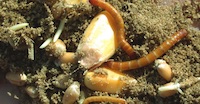Sort through options for wireworm control

Corn Bug Beat: Here's what you should know about wireworms in corn.
Tom J Bechman 1 | Jan 31, 2017
Are you likely to see wireworms in every cornfield this spring? No. Almost any entomologist or crop consultant would tell you so. Can you afford to ignore them altogether? Do so at your own peril.
That’s the background for this question:
I’ve had wireworms before in certain fields. I’m considering four options: 1) use insecticide-coated seed corn only in those fields; 2) use it in all fields; 3) don’t use it at all but scout and treat if I find them; or 4) put out bait traps and use seed coated with insecticide if I find them. Which option makes the most economic sense?
A panel of experts addresses this question. Indiana Certified Crop Advisers include: Jesse Grogan, agronomist, LG Seeds, Lafayette; Greg Kneubuhler, crops consultant and owner of G&K Concepts, Harlan; and Tom Stein, manager of the Templeton and Boswell branches for Ceres Solutions LLC.
Stein: Wireworms can cause significant damage to both corn and soybeans by attacking seeds before, during or after germination. They can also feed on emerged seedlings, causing stunting and even plant death. Populations will be higher in no-till, wet or weed fields, or after perennial sod or a cover crop. There are no rescue treatments for wireworms. Do due diligence prior to planting instead. Bait stations are a good tool to assess potential wireworm problems.
Kneubuhler: Wireworms are a lengthy pest in that they can have a multiple-year life cycle. They can persist up to seven years. If you know you have wireworms or a history of them, I wouldn’t hesitate to, at a minimum, run a seed-applied insecticide. Seed-applied insecticides are generally effective in low to moderate infestations of wireworms. If you know the pressure is high, use a soil-applied insecticide.
Grogan: The most cost-effective wireworm control is seed treatment insecticide, especially when there’s a history of wireworm problems. Bait stations are a method to determine the potential of wireworm damage before planting, but they’re rarely used because of the time and labor required to place and evaluate traps. Seed insecticide is included with biotech corn seed, at least at a lower rate. It has effectiveness for wireworm control. Higher rates of seed-applied insecticide can be used in problem fields. Plan for the use of seed insecticide in corn, and use a lower or higher rate depending upon the possibility of insect injury.
Kneubuhler: If you’re unsure of wireworm pressure, set up bait traps two to three weeks before planting. It may be difficult to change your approach in that kind of time frame, however.
Stein: To set up a bait station, locate five random spots in a field and dig holes 6 inches deep. Put untreated corn or wheat in an old sock, water it and cover it with soil and black plastic. Flag them; then return two weeks later, dig them up, and count wireworms per station. If you average one per station, at least use the high rates of seed insecticide (Poncho 1250 or Cruiser Maxx 1250.) If you find more than one per station, consider a liquid or granular soil insecticide instead.

